weight PEUGEOT EXPERT 2018 Owners Manual
[x] Cancel search | Manufacturer: PEUGEOT, Model Year: 2018, Model line: EXPERT, Model: PEUGEOT EXPERT 2018Pages: 416, PDF Size: 14.12 MB
Page 75 of 416
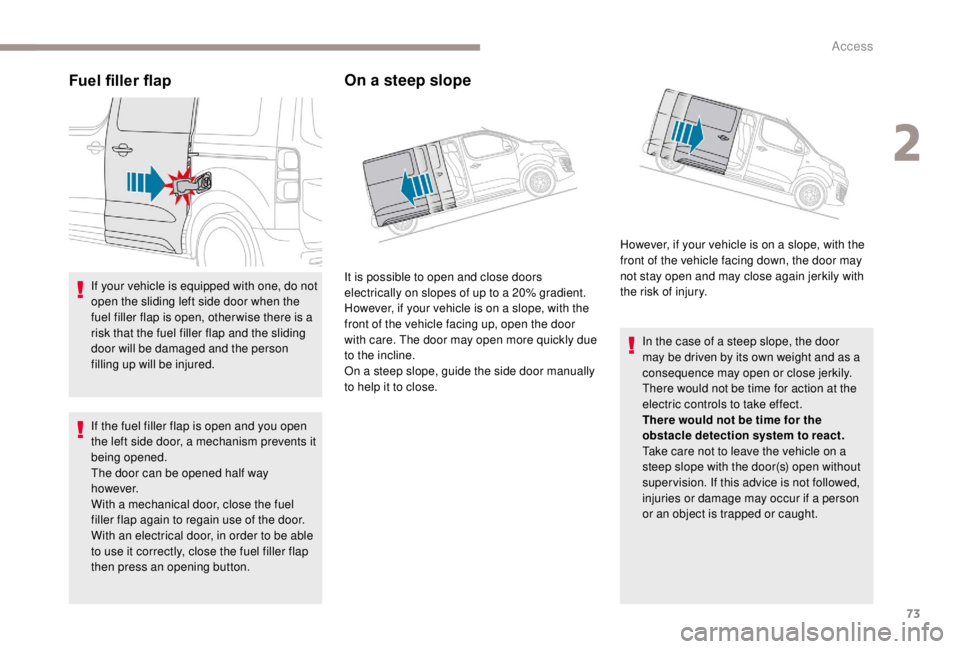
73
Fuel filler flap
If your vehicle is equipped with one, do not
open the sliding left side door when the
fuel filler flap is open, other wise there is a
risk that the fuel filler flap and the sliding
door will be damaged and the person
filling up will be injured.
If the fuel filler flap is open and you open
the left side door, a mechanism prevents it
being opened.
The door can be opened half way
h o w eve r.
With a mechanical door, close the fuel
filler flap again to regain use of the door.
With an electrical door, in order to be able
to use it correctly, close the fuel filler flap
then press an opening button.
On a steep slope
It is possible to open and close doors
electrically on slopes of up to a 20% gradient.
However, if your vehicle is on a slope, with the
front of the vehicle facing up, open the door
with care. The door may open more quickly due
to the incline.
On a steep slope, guide the side door manually
to help it to close.However, if your vehicle is on a slope, with the
front of the vehicle facing down, the door may
not stay open and may close again jerkily with
the risk of injury.
In the case of a steep slope, the door
may be driven by its own weight and as a
consequence may open or close jerkily.
There would not be time for action at the
electric controls to take effect.
There would not be time for the
obstacle detection system to react.
Take care not to leave the vehicle on a
steep slope with the door(s) open without
supervision. If this advice is not followed,
injuries or damage may occur if a person
or an object is trapped or caught.
2
Access
Page 159 of 416

157
General points relating to
child seats
* The legislation on carrying children is specific to each country.
Although one of PEUGEOT's main
considerations when designing your vehicle,
the safety of your children also depends on
you.
For maximum safety, please obser ve the
following recommendations:
-
I
n accordance with European regulations,
all children under the age of 12
or less
than one and a half metres tall must
travel in an approved child seat suited to
their weight and installed on a vehicle seat
fitted with a seat belt or ISOFIX mountings*.
-
S
tatistically, the safest seats in your
vehicle for carr ying children are the rear
seats.
-
A c
hild weighing less than 9
kg must
travel in the rear ward facing position
both in the front and in the rear.
PEUGEOT recommends that children
should travel on the rear seats of your
vehicle:
-
re
arward facing
up to the age of 3,
-
fo
rward facing
over the age of 3.
Child seat at the rear
Row 2
Ensure that the seat belt is properly
tightened.
For child seats with a support leg, ensure
that the latter is in firm contact with the
floor. If necessary, adjust the front seat of
the vehicle.
"Rearward facing"
When a "rear ward facing" child seat is installed
on a rear passenger seat , move the vehicle's
front seat for ward and straighten the backrest
so that the rear ward facing child seat does not
touch the vehicle's front seat.
Adjust the rear seat to the fully back position,
with the backrest straightened.
"Forward facing"
When a "for ward facing" child seat is installed
on a rear passenger seat , move the vehicle's
front seat for ward and straighten the backrest
so that the legs of the child in the for ward
facing child seat do not touch the vehicle's front
seat.
Adjust the rear seat to the fully back position,
with the backrest straightened.
5
Safety
Page 166 of 416

164
Locations for child seats secured using the seat belt
In line with European legislation, the table indicates the options for installing child seats secured using a seat belt and universally approved (a) for the
weight of the child and the seat in the vehicle.Seats Weight of the child and indicative age
Under 13 kg (groups 0 (b) a n d 0 +)
Up to about 1 year 9 -18 kg
(g r o u p 1)
From about 1 to 3
years15 -25 kg
(group 2)
From about 3 to 6
years22-36 kg
(group 3)
From about 6 to 10
years
Cab/Row 1 (c) (f ) With individual seat,
passenger seat U
UUU
With bench seat, outer seat UUUU
With bench seat, centre seat XXXX
*
T
he folding bench seat is in the process of being approved.
Row 2 (d)
Left outer seat
UUUU
Centre seat UUUU
Right outer seat UUUU
Safety
Page 167 of 416
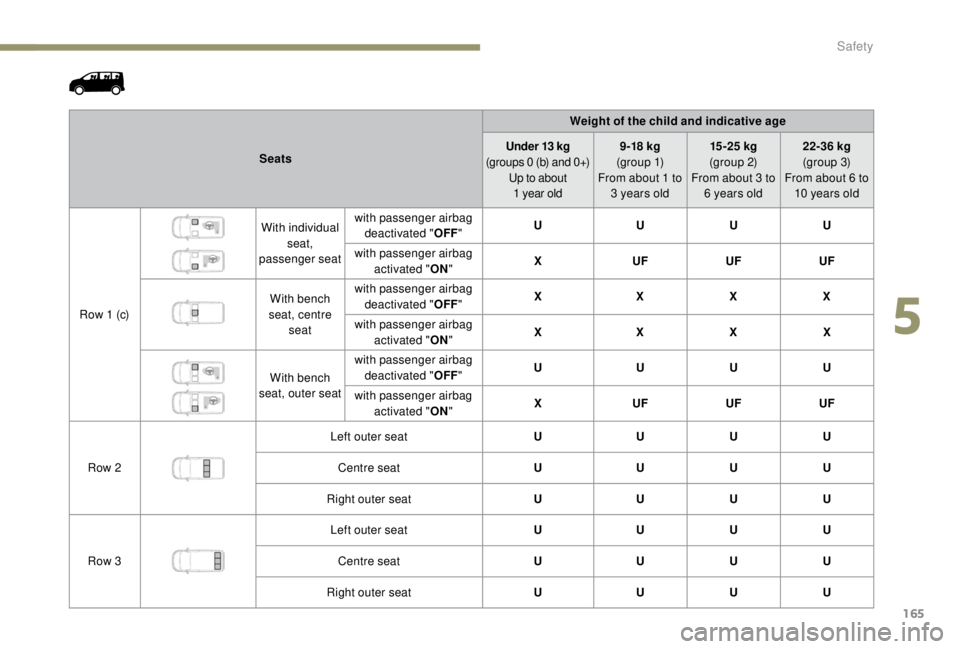
165
SeatsWeight of the child and indicative age
Under 13 kg
(groups 0 (b) and 0+)
Up to about
1
year old9 -18
kg
(g r o u p 1)
From about 1 to 3
years old15 -25
kg
(group 2)
From about 3 to 6
years old22-36
kg
(group 3)
From about 6 to 10
years old
Row 1
(c) With individual
seat,
passenger seat with passenger airbag
deactivated " OFF" U
UUU
with passenger airbag activated " ON" X
UFUFUF
With bench
seat, centre seat with passenger airbag
deactivated " OFF" X
XXX
with passenger airbag activated " ON" X
XXX
With bench
seat, outer seat with passenger airbag
deactivated " OFF" U
UUU
with passenger airbag activated " ON" X
UFUFUF
Row 2 Left outer seat
UUUU
Centre seat UUUU
Right outer seat UUUU
Row 3 Left outer seat
UUUU
Centre seat UUUU
Right outer seat UUUU
5
Safety
Page 168 of 416
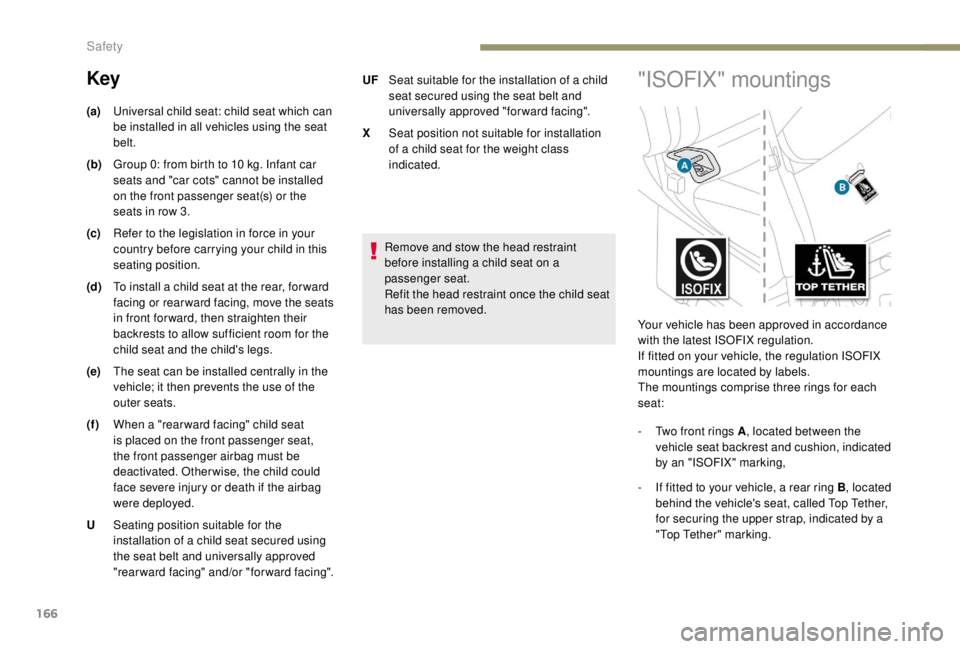
166
Remove and stow the head restraint
before installing a child seat on a
passenger seat.
Refit the head restraint once the child seat
has been removed.
(a)
Universal child seat: child seat which can
be installed in all vehicles using the seat
belt.
(b) Group 0: from birth to 10
kg. Infant car
seats and "car cots" cannot be installed
on the front passenger seat(s) or the
seats in row 3.
(c) Refer to the legislation in force in your
country before carrying your child in this
seating position.
(d) To install a child seat at the rear, for ward
facing or rear ward facing, move the seats
in front for ward, then straighten their
backrests to allow sufficient room for the
child seat and the child's legs.
(e) The seat can be installed centrally in the
vehicle; it then prevents the use of the
outer seats.
(f ) When a "rear ward facing" child seat
is placed on the front passenger seat,
the front passenger airbag must be
deactivated. Otherwise, the child could
face severe injury or death if the airbag
were deployed.
U Seating position suitable for the
installation of a child seat secured using
the seat belt and universally approved
"rearward facing" and/or "forward facing". UF
Seat suitable for the installation of a child
seat secured using the seat belt and
universally approved "forward facing".
X Seat position not suitable for installation
of a child seat for the weight class
indicated.
Key"ISOFIX" mountings
Your vehicle has been approved in accordance
with the latest ISOFIX regulation.
If fitted on your vehicle, the regulation ISOFIX
mountings are located by labels.
The mountings comprise three rings for each
seat:
-
T
wo front rings A , located between the
vehicle seat backrest and cushion, indicated
by an "ISOFIX" marking,
-
I
f fitted to your vehicle, a rear ring B , located
behind the vehicle's seat, called Top Tether,
for securing the upper strap, indicated by a
"Top Tether" marking.
Safety
Page 171 of 416
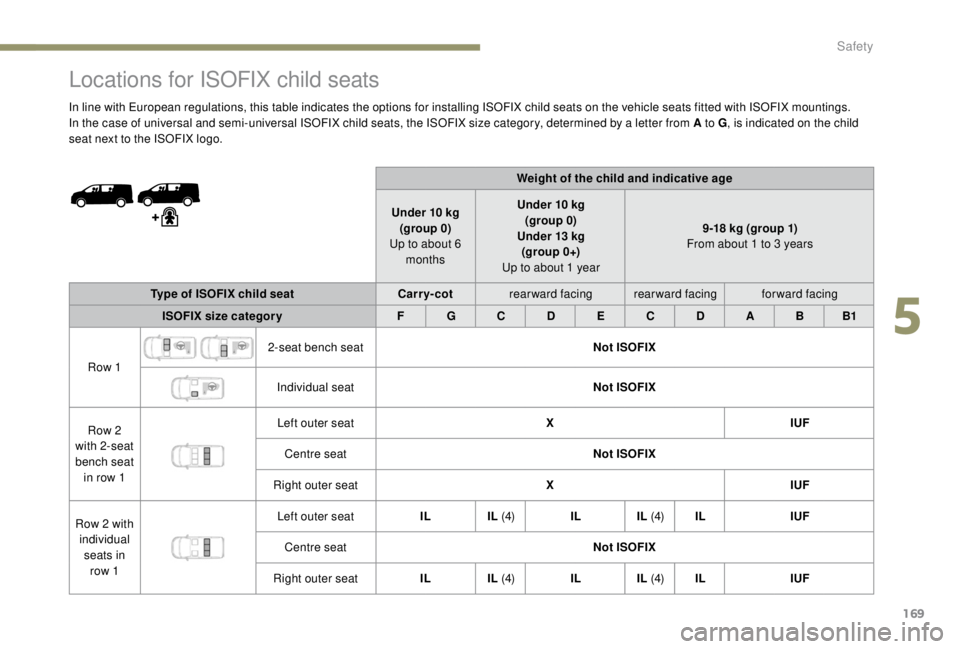
169
Locations for ISOFIX child seats
In line with European regulations, this table indicates the options for installing ISOFIX child seats on the vehicle seats fitted with ISOFIX mountings.
In the case of universal and semi-universal ISOFIX child seats, the ISOFIX size category, determined by a letter from A to G, is indicated on the child
seat next to the ISOFIX logo.
Weight of the child and indicative age
Under 10 kg (group 0)
Up to about 6 months Under 10 kg
(group 0)
Under 13 kg (group 0+)
Up to about 1 year 9-18 kg (group 1)
From about 1 to 3 years
Type of ISOFIX child seat Carr y- cotrearward facing rearward facing forward facing
ISOFIX size categor y F G C D E C D A B B1
Row 1 2-seat bench seat
Not ISOFIX
Individual seat Not ISOFIX
Row 2
with 2-seat
bench seat in row 1 Left outer seat
XIUF
Centre seat Not ISOFIX
Right outer seat XIUF
Row 2 with individual seats in row 1 Left outer seat
IL IL (4)IL IL (4)IL IUF
Centre seat Not ISOFIX
Right outer seat IL IL (4)IL IL (4)IL IUF
5
Safety
Page 172 of 416
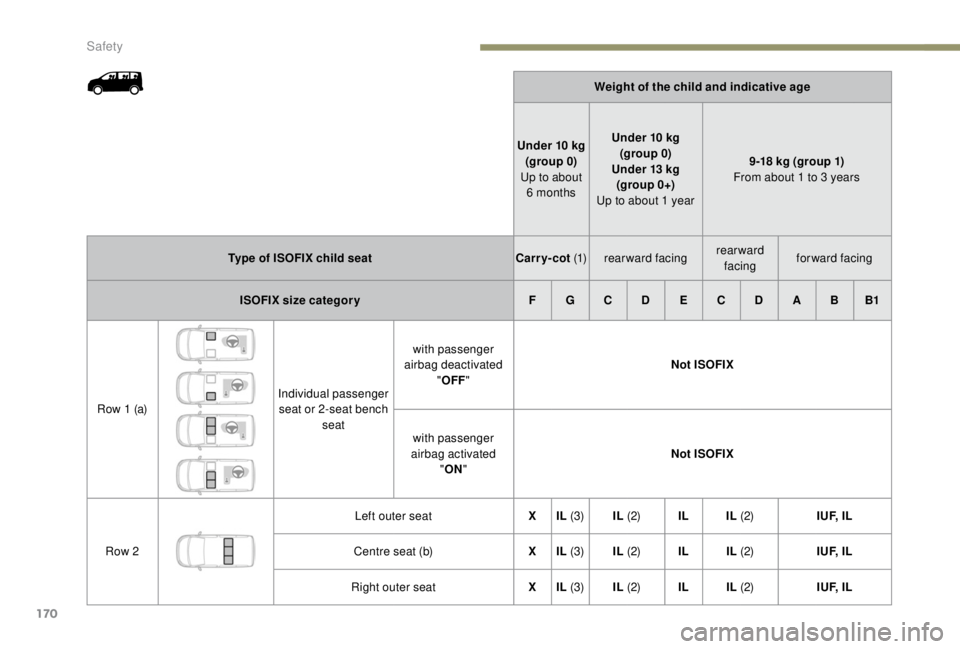
170
Weight of the child and indicative age
Under 10
kg
(group 0)
Up to about 6
months Under 10
kg
(group 0)
Under 13
kg
(group 0+)
Up to about 1
year 9-18
kg (group 1)
From about 1
to 3 years
Type of ISOFIX child seat Carr y- cot (1)rearward facing rearward
facing forward facing
ISOFIX size categor y F G C D E C D A B B1
Row 1
(a) Individual passenger
seat or 2-seat bench seat with passenger
airbag deactivated "OFF " Not ISOFIX
with passenger
airbag activated "ON " Not ISOFIX
Row 2 Left outer seat
XIL (3) IL (2) IL IL (2) I U F, I L
Centre seat (b) XIL (3) IL (2) IL IL (2) I U F, I L
Right outer seat XIL (3) IL (2) IL IL (2) I U F, I L
Safety
Page 173 of 416
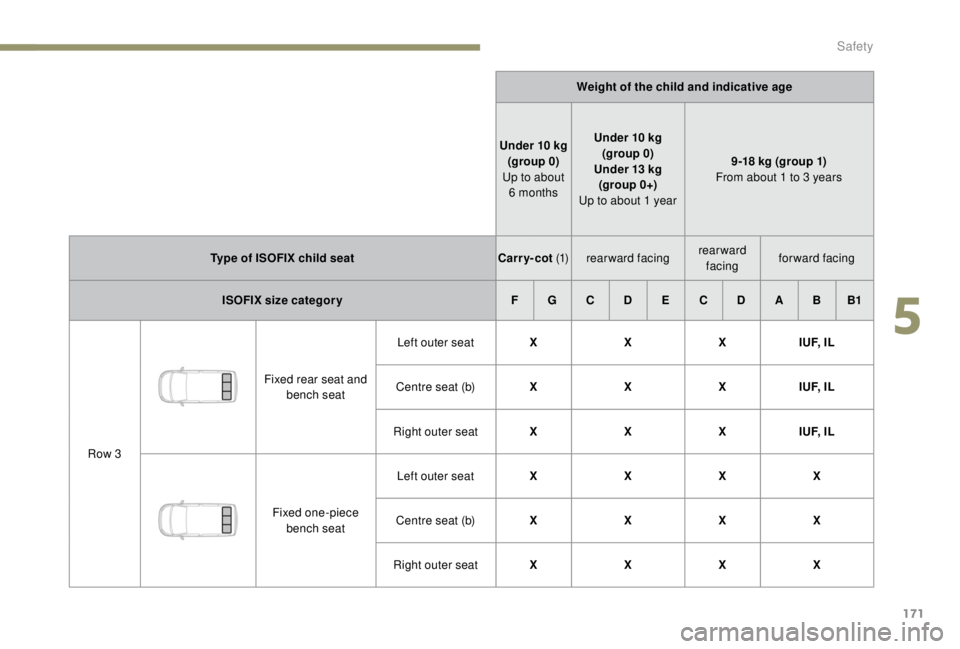
171
Weight of the child and indicative age
Under 10
kg
(group 0)
Up to about 6
months Under 10
kg
(group 0)
Under 13
kg
(group 0+)
Up to about 1
year 9-18
kg (group 1)
From about 1
to 3 years
Type of ISOFIX child seat Carr y- cot (1)rearward facing rearward
facing forward facing
ISOFIX size categor y F G C D E C D A B B1
Row 3 Fixed rear seat and
bench seat Left outer seat
XXXI U F, I L
Centre seat (b) XXXI U F, I L
Right outer seat XXXI U F, I L
Fixed one-piece bench seat Left outer seat
XXX X
Centre seat (b) XX XX
Right outer seat XX XX
5
Safety
Page 174 of 416

172
(a)Refer to the legislation in force in your
country before carrying your child in this
seating position.
(b) The seat can be installed centrally in the
vehicle; it then prevents the use of the
outer seats.
IUF Seat suitable for installing an I sofix
U niversal seat, " For ward facing", secured
using the upper strap.
IL Seat suitable for an I sofix semi-universaL
child seat which is either:
-
"
rear ward facing" fitted with an upper
strap or a support leg,
-
"
for ward facing" fitted with a support
leg,
-
a c
arry-cot seat fitted with an upper
strap or a support leg.
X Seat unsuitable for the installation of an
ISOFIX seat or cot of the weight group
indicated.
(1) The installation of a cot on this seat may
prevent the use of one or more of the
other seats in this row.
(2) Installation possible only behind the
driver's seat. For more information on the ISOFIX
mountings
and in particular the upper
strap, refer to the corresponding section.
Remove and stow the head restraint
before installing a child seat on a
passenger seat.
Refit the head restraint when the child
seat is removed.
Key(3) Installation possible only behind the
driver's seat with individual passenger
seat.
(4) The front seat must be adjusted so that
there is no contact between the child in
row 2 and the seat immediately in front
(with the front seat adjusted to 2 notches
ahead of the centre of the slide).
Safety
Page 179 of 416

177
Manoeuvre cautiously, at low
speed
The dimensions of your vehicle differ from
those of a light vehicle, in width, in height, as
well as in length, and some obstacles will be
more difficult to notice.
Manoeuvre slowly.
Before turning, check that there are no
obstacles at mid-height along the sides.
Before reversing, check that there are no
obstacles, particularly at high level behind the
vehicle.
Be aware of the external dimensions, if ladders
are fitted.
Load the vehicle correctly
With a load carried, the vehicle must remain
within the maximum authorised weight, the
Gross Vehicle Weight.
To avoid upsetting the balance of the vehicle,
the load should be centred and the heaviest
part placed on the floor in front of the rear
wheels.
It is inadvisable to place heavy loads on a roof
rack.
Loading also implies adherence to the
maximum load of the roof bar anchor points.
Adhere to the maximum permissible weight,
according to PEUGEOT dealer specifications.
Loads must be securely lashed down.
A load that is not properly secured inside the
vehicle may affect vehicle handling and create
a risk of accident.
Drive the vehicle in a prudent
and efficient way
Take corners gently.
Anticipate the need to brake as the stopping
distance is increased, particularly on wet or icy
roads.
Be aware of the effect of side winds on the
vehicle.
Effective eco-driving saves fuel; accelerate
progressively, anticipate the need to slow down
and adapt your speed to suit the situation.
Indicate changes of direction well in advance
so that you are seen by other road users.
Take care
The tyres must be inflated to at least the
pressures indicated on the label, even over-
inflated by 0.2 to 0.3 bar for long journeys.
If your vehicle is fitted with a drop-side back,
the height and width of the load must remain
within the overall dimensions of the vehicle.
In case of towing
Driving with a trailer places greater
demands on the towing vehicle and
requires extra care from the driver.
Distribution of loads
F Distribute the load in the trailer so that
the heaviest items are as close as possible
to the axle and the nose weight approaches
the maximum permitted without
exceeding it.
Air density decreases with altitude, thus
reducing engine performance. The maximum
towed load must be reduced by 10% for every
1,000
metres of altitude.
Please respect the maximum towable
weights.
Side wind
F Take into account the increased sensitivity to wind.
6
Driving